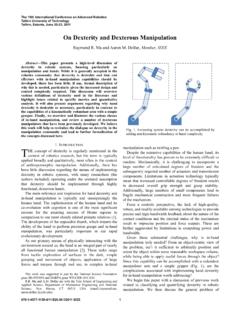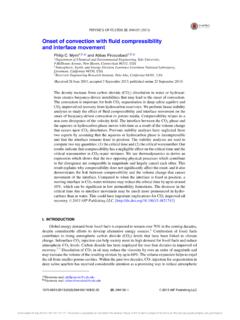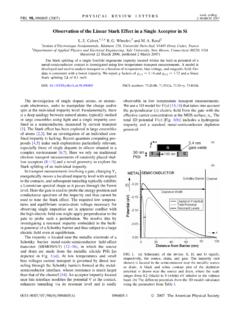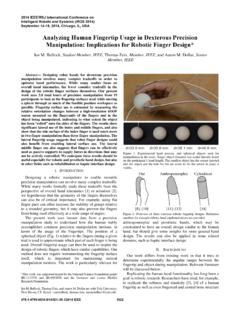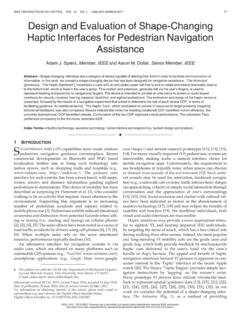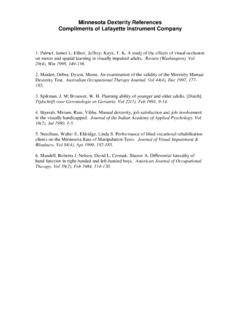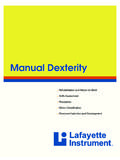Transcription of Vision-Based Precision Manipulation with …
1 +//,. Abstract In this paper, a method is proposed for Vision-Based within-hand Precision Manipulation with underactuated grippers. The method combines the advantages of adaptive underactuation with the robustness of visual servoing algorithms by employing simple action sets in actuator space, called Precision Manipulation primitives (PMPs). It is shown that, with this approach, reliable Precision Manipulation is possible even without joint and force sensors by using only minimal gripper kinematics information. An adaptation method is also utilized in the vision loop to enhance the system s transient performance.
2 The proposed methods are analyzed with experiments using various target objects and reference signals. The results indicate that underactuated hands, even with minimalistic sensing and control via visual servoing, can provide a simple and inexpensive solution to allow low-fidelity Precision Manipulation . I. INTRODUCTION Gripper dexterity brings flexibility to robotic object Manipulation : Besides enriching the possibilities for object grasping, dexterity reduces task specific dependencies on initial grasp configuration by enabling Precision (within-hand) object Manipulation . Such properties are especially important for home/service robots, which are expected to manipulate daily-life objects that are designed for dexterous human hand.
3 In addition, gripper dexterity, and in particular Precision fingertip-based Manipulation , helps to avoid joint limits of the robot and increases energy efficiency of the system by obviating the need for larger arm motions [1], [2]. Assuming that the gripper model, object model, and contact locations are accurately known and joint states can be measured, Precision Manipulation can be implemented by utilizing the models in [3] [7]. These models calculate gripper actuator positions for a given desired object pose, along with conditions to satisfy force balance in quasi-static cases given a contact model. Nonholonomic motions of the object within hand (such as sliding) are neglected.
4 Unfortunately these assumptions are far from being realistic in unstructured environments in which object models are usually unknown a priori, nonholonomic motions are common and assumptions on contact models may not exactly hold in practice. Combination of these modeling errors results in significant steady state error or even dropping the target object. Using vision feedback is a natural solution to some of the aforementioned problems. Robustness to modeling Research supported by National Science Foundation under the grant IIS-1317976. B. Calli and A. M. Dollar are with the Dep. of Mech. Eng. and Mater. Science, Yale University, CT, USA inaccuracies can be achieved by taking inherent advantages of some visual servoing methods.
5 Even though Vision-Based Precision Manipulation methods are presented in literature for fully-actuated grippers, no methods are proposed for underactuated grippers. In this work we examine Vision-Based Precision Manipulation with underactuated grippers (Fig. 1). Using vision feedback and minimal information about the underactuated mechanism, we achieved accurate positioning while maintaining a stable grasp without the use of any joint encoders or force sensors. This success is due to combining the robustness of visual servoing methods with the contact stability provided by adaptive underactuation via Precision Manipulation primitives (PMPs). It was observed that the proposed simple architecture is robust to contact position changes and nonholonomic motions of the object within hand.
6 For improving the system s transient response, an adaptive method was also employed. Apart from being the first work that focuses on visual servoing techniques applied to underactuated hands, the novelty of the paper also lies in our proposed methodology that uses Manipulation primitives for Vision-Based Precision Manipulation . Moreover, unlike many previous works, which provide limited experimental evaluation, we present extensive set of experiments for performance analysis. In the next section, we summarize the literature on Precision Manipulation and its Vision-Based implementations. In Section III our proposed method is explained. Following that, Section IV provides experimental results, and Section V concludes the paper with discussions.
7 Vision-Based Precision Manipulation with Underactuated Hands: Simple and Effective Solutions for Dexterity Berk Calli, Member IEEE, Aaron M. Dollar, Senior Member, IEEE Figure 1. Precision Manipulation via vision feedback using an underactuated hand: Controlling the position of the object center for following a trajectory in the image space. 2016 IEEE/RSJ International Conference on Intelligent Robots and Systems (IROS)Daejeon Convention CenterOctober 9-14, 2016, Daejeon, Korea978-1-5090-3762-9/16/$ 2016 IEEE1012 II. RELATED WORK In this section, the literature on Precision Manipulation and the use of visual servoing algorithms in the field are summarized. A. Underactuated Grippers and Precision Manipulation Underactuated grippers are proved to be useful for many robotic grasping scenarios.
8 with their unconstrained degrees of freedom which allow them to reconfigure, they adapt to the object shape, increase the contact with the object and maintain a stable grasp [8], [9]. In addition, due to the reduced number of actuators, underactuated architectures allow compact designs and provide cheap solutions. It is also shown in literature that these grippers are capable of Precision Manipulation [10] [13]. Nevertheless, additional design considerations are necessary to maintain a stable pinch grasp during the Manipulation . In [11], stability of Precision Manipulation with underactuated hands are examined and it is concluded that there must be elastic elements, which provide a restoration force for any unconstraint motion of the hand-object couple.
9 These forces should be large enough for the hand to deliver enough normal force to the object in order to avoid slipping and sliding. The required force can be reduced by using a higher friction finger surface. Once the abovementioned design criteria are met, even open-loop Precision Manipulation is possible with underacted hands, since the mechanical restoration force will maintain the contact between the object and the finger without the need of any sophisticated control and planning algorithms (this property is essential for this paper and will be re-visited in Section III). This is, of course, valid only within the gripper s Manipulation workspace, which is studied in [10], [11]; due to underactuation, the portion of the Cartesian workspace spanned by the gripper is limited to its degrees of freedom and actuator arrangements.
10 The Precision Manipulation strategies with underactuated grippers ( [10] [13]) often require an accurate knowledge of gripper model, object model and contact locations (an exception with unknown object models is given in [14] where a particular gripper morphology is needed). Using these information, Precision Manipulation can be analyzed by energy minimization methods [11] or by considering the hand-object system as a parallel robot [15]. Unfortunately, generating accurate models for underactuated grippers are difficult due to their elastic elements and friction. Moreover, in most Precision Manipulation scenarios, contact locations may not be accurately known or may change in time due to nonholonomic motions.
